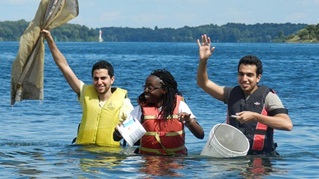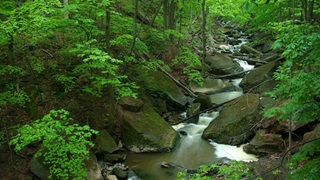Keeping a watchful eye on a wondrous watershed
Niagara Peninsula Conservation Authority promotes education, restoration and recreation
It’s the bee’s knees. It’s an outdoor lab adventure, ESI (Environmental Scene Investigation) style. It’s a wild ride for Mr. Toad, and all his other amphibious acquaintances.
Educational programming hosted by the Niagara Peninsula Conservation Authority is all of that—and much, much more.
For nearly 60 years, the NPCA has worked to preserve the Niagara Peninsula watershed—one of the most complex watersheds in Ontario—through recreation, restoration and conservation education.
And it’s here at Ball’s Falls Conservation Area, the NPCA’s center of educational offerings, where nature really comes to life.
“We’re always trying to find new ways to show children and families the nature that’s all around us,” says Jill Walters-Klamer, who’s developed much of the NPCA’s educational programming.
“We definitely have a wonderful curriculum in place,” adds Renee Bisson, the NPCA’s Community Engagement Manager. “And we’re working hard to grow regional demand for the program.”
The NPCA manages 39 conservation areas totaling more than 7,000 acres, including some of the most ecologically sensitive and unique natural areas in the Niagara region.
Between school field trips and week-long camps, the NPCA connects about 7,200 students with nature at Ball’s Fall’s every year, through innovative curriculum-based and inquiry-based programming like:
- It’s A Bee’s Life, which zooms in on the life of these amazing insects and what we can do to save them;
- Sphagnum P.I.: The Case of the Stray Squirrel, which examines why the flying squirrel is disappearing from the area (and Ontario in general);
- Human Impact on the Environment, a study of invasive species and their effect on native plants;
- Water Quality, an ongoing examination of the region’s water systems health through hands-on data collection; and
- Amazing Amphibians, an investigation of the local pond for frogs, toads and salamanders.
Enbridge is committed to improving the quality of life in the communities near our operations and projects—including the Line 10 Westover Segment Replacement Project, which will enhance the safety and reliability of our system to deliver the energy people rely on every day.
“We take responsibility to the environment seriously, and we are proud to invest in community programs that promote environmental stewardship, conservation, habitat remediation and education,” says Ken Hall, an Ontario-based senior advisor of community engagement for Enbridge.
In recent months, that included a $5,000 donation to the NPCF for the construction of a floating dock in the Ball’s Falls Conservation Area—a development that will enhance programs like Amazing Amphibians.
“Our pond at Ball’s Falls is home for green frogs and northern leopard frogs, as well as a nursery for toads and insects,” says Walters-Klamer. “Starting in June, we’ll be using the new dock constantly for summer camps, and then regular school visits.”
Adds Bisson: “It’s another tool for our exploration of the world of water—and a real spark for curiosity, which leads to the love of nature.”










